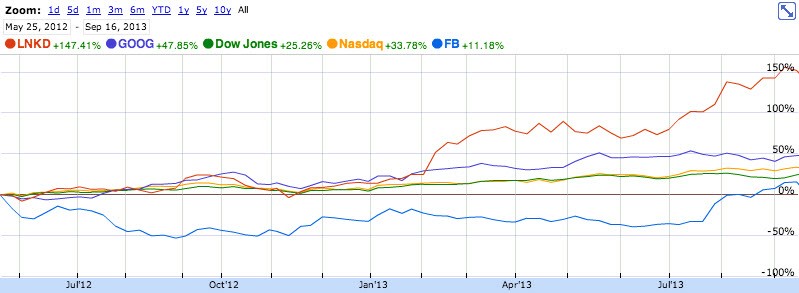Twitter’s imminent share float will test the strength of the company’s strategies to become a new kind of news channel and to embed itself as the television industry’s “second screen” — all driven by an assumed-to-be-forthcoming surge in mobile advertising.
Comparisons with Facebook are inevitable. Twitter will be the biggest “technology” float since Facebook went public last year — in this strange business taxonomy where new-ish communications and media companies get labelled “tech” because they use computers, as opposed to all the other communications and media companies that … oh whatever — and Facebook’s float was a debacle.
Facebook aimed high, claiming a valuation of around US$100 billion. Too high, as it turned out. The share price plummeted from its opening at US$38 to under half that. Only in recent weeks have Facebook shares risen above the issue price. They still substantially trail both the NASDAQ and the Dow Jones …
The Silicon Valley rumour mill suggests Twitter will aim more realistically — but we can’t know for sure. Twitter has taken advantage of the Jump-Start Our Business Startups (JOBS) Act, a 2012 law that allows businesses with revenues under US$1 billion to file and negotiate their IPO documents with regulators confidentially, revealing them in final form just 21 days before they float — a law that funds manager Joe Spiegel at the gloriously named Dalek Capital says “is really awful for investors”.
Recent private share sales by Twitter employees have pegged the valuation at around US$9 billion, and figures of US$10-15 billion are being kicked around for the IPO. That’s certainly in the right ballpark.
Digital marketing analyst firm eMarketer says Twitter will generate US$582 million in revenue for the 2013 calendar year, most of it from advertising. That represents solid growth, following revenues of US$288 million in 2012 and US$139 million in 2011. Twitter is currently the 11th most-visited web property globally, and eighth in the US, according to Alexa, with visitors spending on average 10:24 minutes on site per day visiting 5.80 pages.
Compare this with Facebook’s number one spot globally, with users spending on average 33:47 on site per day visiting 15.86 pages, and Facebook’s market capitalisation of US$104 billion.
To add in another metric, comScore’S Top 50 US Web Properties for July 2013 gives Facebook 140 million unique US web browsers per month, Twitter 36.5 million.
A very crude combination of the two — US unique browsers multiplied by minutes per day — would measure Facebook as roughly 12 times the heft of Twitter. But a Twitter valued at US$10 billion would give Facebook just 10 times the heft. A US$15 billion Twitter places Facebook just seven times bigger.
Can Twitter justify the higher price? Perhaps.
There’s been talk of Facebook usage figures reaching a plateau for two years or more, but the last few days have brought reports that Twitter, too, is growing more slowly than expected. But the real future battlespace will be mobile devices — and here Twitter has distinct advantages.
Twitter’s (in)famous 140-character limit on the size of its messages was born of the limitations of mobile media, turning it into a strength. Facebook has traditionally struggled with mobile users, paying US$1 billion for Instagram shortly before its own share float to capture that company’s expertise, user base and credibility — but it’s only now starting to experiment with advertising on Instagram.
Meanwhile, Twitter has just bought MoPub, a mobile advertising exchange start-up, for US$350 million in stock — a strategic move that seems to have earned the nod of the Valley cognoscenti.
Twitter has always been a niche player, but that niche has been heavily populated by communications professionals, including politicians, marketers — and the media itself. Twitter is now an essential part of both news-gathering and news dissemination, and it has been experimenting with adding links to related news stories. And on the entertainment side, second screen usage — tweeting on a mobile device while watching TV — is a growing activity.
Here in Australia, ABC TV’s Q&A is consistently the biggest live second-screen experience. TweeVee TV founder Leslie Nassar told Crikey this morning that Q&A typically draws an average of 6000-7000 unique Twitter participants. OzTAM reports that last night’s episode drew a five-city metro audience of 705,000 viewers, so the tweeters are just 1% of the broadcast audience — but it’s growing.
“These second screen folks are more significantly engaged in the second screen experience itself. They’re tweeting during the ep and during broadcast commercials. They’re not channel surfing during ad breaks, they’re on IMDb or Twitter or Facebook, so they’re still within the context of what they’re watching, and that’s where the value is.
“Whoever owns the second screen — and its associated advertising ecosystem — also owns the hyper-engaged, generally affluent, audience that goes with it.”
Twitter has recently been experimenting with a “TV trending” box to highlight tweets about current TV programs, and delivering Twitter ads as a one-two punch to follow-up TV commercials.
Twitter’s brevity is a natural fit for this environment. Twitter and the TV industry are eyeing each other off, although it’s far from obvious how the market forces will play out long term.









Hopefully this will stop Twitter ever expanding its tweet length beyond 140 characters. That was a limitation set by text messaging – which was how I originally tweeted before getting a smartphone – and I worried that the company would feel the need to match Facebook’s longer post limits. But perhaps the enforced brevity has been recognised as a key strength, as you state.